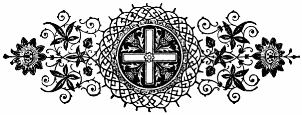
Saint Eligius, Bishop
|

Saint Eligius, Bishop![]() December 1st
December 1st ![]()
Bishop of Noyon-Tournai, born at Chaptelat near Limoges, France, c. 590, of Roman parents, Eucherius and Terrigia; died at Noyon, 1 December, 660. His father, recognizing unusual talent in his son, sent him to the noted goldsmith Abbo, master of the mint at Limoges. Later Eligius went to Neustria, where he worked under Babo, the royal trasdurer, on whose recommendation Clotaire II commissioned him to make a throne of gold adorned with precious stones. His honesty in this so pleased the king that he appointed him master of the mint at Marseilles, besides taking him into his household. After the death of Clotaire (629), Dagobert appointed his father's friend his chief councillor. The fame of Eligius spread rapidly, and ambassadors first paid their respects to him before going to the king. His success in inducing the Breton King, Judicail, to submit to Frankish authority (636-37) increased his influence. Eligius took advantage of this to obtain alms for the poor and to ransom Roman, Gallic, Breton, Saxon, and Moorish captives, who were arriving daily at Marseilles. He founded several monasteries, and with the king's consent sent his servants through towns and villages to take down the bodies of malefactors who had been executed, and give them decent burial. Eligius was a source of edification at court, where he and his friend Dado (Audoenus) lived according to the Irish monastic rule, introduced into Gaul by St. Columbanus. Eligius introduced this rule, either entirely or in part, into the monastery of Solignac which he founded in 632, and into the convent at Paris where three hundred virgins were under the guidance of the Abbess Aurea. He also built the basilica of St. Paul, and restored that of St. Martial in Paris. He erected several fine churches in honour of the relics of St Martin of Tours, the national saint of the Franks, and St. Denis, who was chosen patron saint by the king. On the death of Dagobert (639), Queen Nanthilde took the reins of government, and Eligius and Dado left the court and entered the priesthood. On the death of Acarius, Bishop of Noyon-Tournai, 13 May, 640, Eligius was made his successor with the unanimnous approbation of clergy and people. The inhabitants of his diocese were pagans for the most part. He undertook the conversion of the Flemings, Antwerpians, Frisians, Suevi, and the barbarian tribes along the coast. In 654 he approved the famous privilege granted to the Abbey of Saint-Denis, Paris, exempting it from the jurisdiction of the ordinary. In his own episcopal city of Noyon he built and endowed a monastery for virgins. After the finding of the body of St. Quentin, Bishop Eligius erected in his honour a church to which was joined a monastery under the Irish rule. He also discovered the bodies of St. Piatus and companions, and in 654 removed the remains of St Fursey, the celebrated Irish missionary (d. 650). Eligius was buried at Noyon. There is in existence a sermon written by Eligius, in which he combats the pagan practices of his time, a homily on the last judgment, also a letter written in 645, in which he begs for the prayers of Bishop Desiderius of Cahors. The fourteen other homilies attributed to him are of doubtful authenticity. His homilies have been edited by Krusch in "Mon. Germ. Hist." (loc. cit. infra).

St. Eligius is particularly honoured in Flanders, in the province of Antwerp, and at Tournai, Courtrai of Ghent, Bruges, and Douai. During the Middle Ages his relics were the object of special veneration, and were often transferred to other resting-places, thus in 881, 1066, 1137, 1255, and 1306. He is the patron of goldsmiths, blacksmiths, and all workers in metal. Cabmen have also put themselves under his protection. He is generally represented in Christian art in the garb of a bishop, a crosier in his right hand, on the open palm of his left a miniature church of chased gold.
Vita Eligii, ed. KRUSCH in Mon. Germ. Hist.; Script. Rerum Merovingicarum, IV, 2, 635 sqq.; Vita metrica Eligii in Catalogus codicum hagiographicorum Bibliothecae regiae Bruxellensis, ed. BOLLANDISTS, I, 470-83; Inventio sancti Quintini in Analecta Bollandiana, VIII, 429 sqq.; DE LINAS, Orfevrerie merovingienne, les aeuvres de S. Eloi et la verroterie cloisonnee (Arras, 1864); DE LAPORTE, Un artiste du 7cme siecle, Eligius aurifaber, S. Eloi, patron des ouvriers en metaux (s.l, 1865); BAPST, Tombeau et chasse de S. Germain, tombeau de Sainte Colombe, tombeau de S. Severin in Revue archeologique, Bk. III (1887); VAREMBERGH, Saint Eloi in Biographie nationale de Belgique, V, 555-58; HAUCK, Kirchengeschichte Deutschlands, I, 296 sqq.; DE VOS, Leven van den heiligen Eligius, met aanteckeningen en bijzonderheden zopens eijnen alouden eeredienst in Vlaanderen (BRUGES, 1900); VAN DER ESSEN, Les relations entre les sermons de Saint Cesaire d'Arles et la predication de Saint Eloi in Bulletin bibliographique du musee Belge (1903), VII; Annuaire de l'Universite de Louvain (1904), 379-90; VAN DER ESSEN, Etude critique et litteraire sur les Vitae de saints merovingiens de l'ancienne Belgique (Louvain, 1907), 324-36; PARSY, Saint Eloi in Les Saints series (Paris, 1907); DE SMET, Analecia Eligiana in Acta SS. Belgii (Brussels, 1785), III, 311-31; KRUSCH, preface, in Mon. Germ. Hist., loc. cit., 635 sqq.
The Catholic Encyclopedia, Volume V
Nihil Obstat, May 1, 1909, Remy Lafort, Censor
Imprimatur. +John M. Farley, Archbishop of New York
|
|